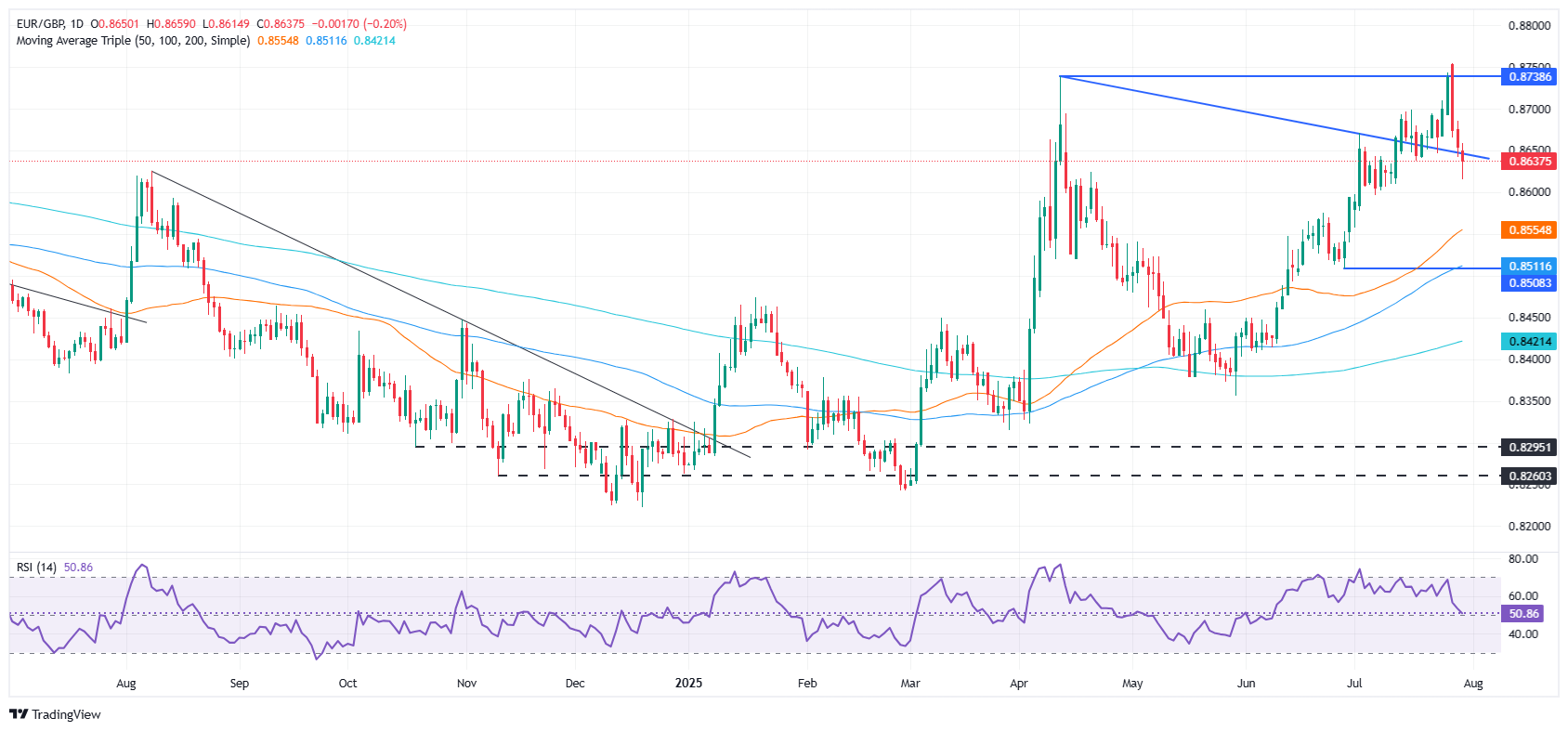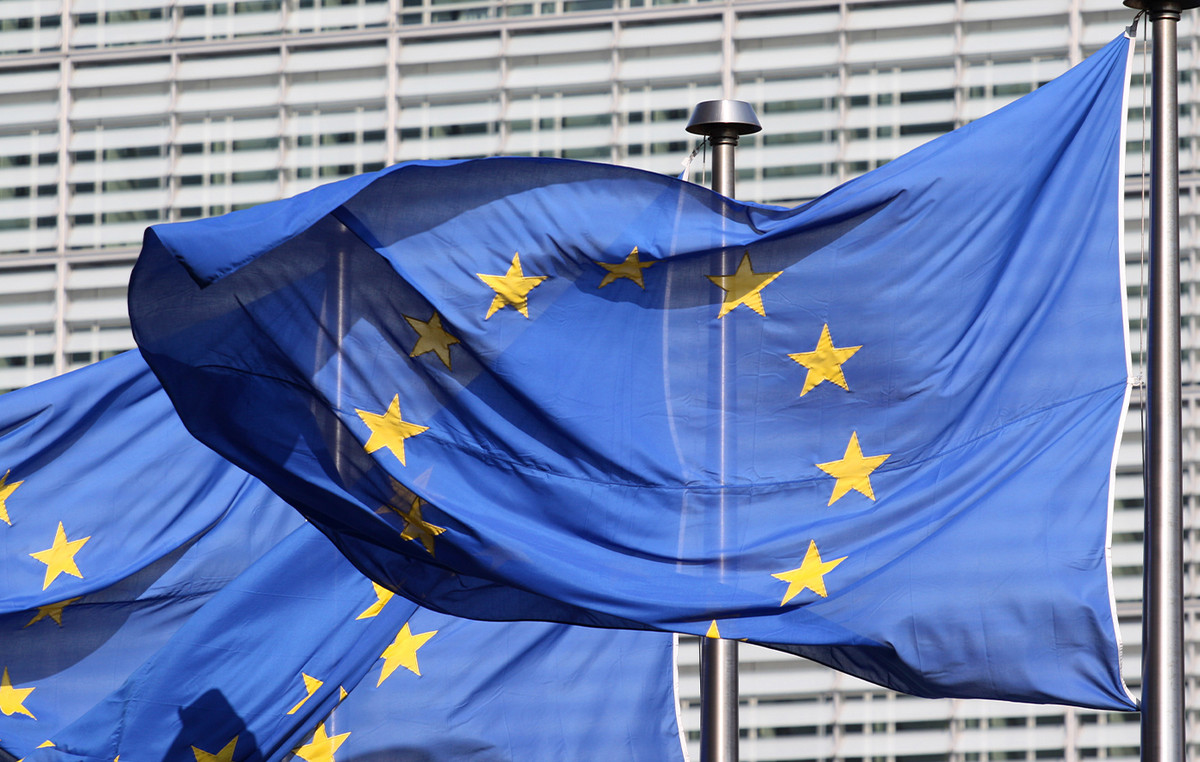- The EUR/GBP falls more than 0.15% as the euro weakens despite the weak economic context of the United Kingdom.
- The GDP of the Eurozone slows to 1.4% year -on -year in the second quarter; Germany recovers with a quarterly growth of 0.4%.
- The BOE cuts rates next week is expected to cut, but the persistent inflation of the United Kingdom keeps the operators cautiously.
The EUR/GBP extended its losses in the early American session, falling more than 0.15% while operators would digest commercial news between the United States (USA) and the European Union (EU). The shared currency has been under pressure since the beginning of the week, although the Bank of England (BOE) is expected to cut rates next week. The pair is quoted at 0.8636 after reaching a maximum of 0.8659.
The euro under pressure despite the weak data of the United Kingdom, while the optimism of the US GDP and the Fed approach weigh on the crossing before the BOE decision
The economic data in the US showed that the economy recovered and grew 3% according to the figures of the Gross Domestic Product (GDP) for the second quarter of 2025. Meanwhile, the operators prepare for the publication of the monetary policy decision of the Federal Reserve, around 18:00 GMT.
Economic data in the EU revealed that the GDP of the block expanded 1.4% year -on -year in the second quarter of 2025, below the expansion of 1.5% in the first quarter. The GDP figures in Germany showed that the economy grew from 0% to 0.4% intertrimestral in the second quarter of 2025.
Retail sales of Germany for June increased an intermensual 1%, compared to a contraction of -1.6% in May, exceeding the forecasts of a growth of 0.5%.
A little economic agenda in the United Kingdom left the operators relying on the publication of GDP and retail sales of last week. The British economy seems to be struggling to grow, while sales did not reach estimates, growing less than expected.
The monetary markets had discounted about 50 basic points of relief by the BOE towards the end of the year. However, inflation in the United Kingdom has proven to be more persistent, and those responsible for policies have become divided over economic perspectives.
EUR/GBP price forecast: technical perspective
The EUR/GBP has fallen below the simple mobile average (SMA) of 0.8657, after reaching an annual peak of 0.8756 on July 28. The relative force index (RSI) fell towards its neutral line, indicating that sellers are accumulating impulse. However, they need to exceed the minimum of July 30, 0.8614 to test 0.8600, with the aim of reaching the 50 -day SMA at 0.8564.
On the contrary, if the EUR/GBP rises above the 20 -day SMA, buyers could point to the 0.8700 figure. If it is exceeded, the next area of interest would be the annual maximum of 0.8756.

EURO – FREQUENT QUESTIONS
The euro is the currency of the 19 countries of the European Union that belong to the Eurozone. It is the second most negotiated currency in the world, behind the US dollar. In 2022, it represented 31 % of all foreign exchange transactions, with an average daily business volume of more than 2.2 billion dollars a day. The EUR/USD is the most negotiated currency pair in the world, with an estimate of 30 %of all transactions, followed by the EUR/JPY (4 %), the EUR/GBP (3 %) and the EUR/AU (2 %).
The European Central Bank (ECB), based in Frankfurt (Germany), is the Eurozone reserve bank. The ECB establishes interest rates and manages monetary policy. The main mandate of the ECB is to maintain price stability, which means controlling inflation or stimulating growth. Its main tool is the rise or decrease in interest rates. Relatively high interest rates (or the expectation of higher types) usually benefit the euro and vice versa. The GOVERNMENT BOOK of the ECB makes decisions about monetary policy in meetings that are held eight times a year. The decisions are made by the directors of the National Banks of the Eurozone and six permanent members, including the president of the ECB, Christine Lagarde.
Eurozone inflation data, measured by the harmonized consumer prices index (IPCA), are an important economic indicator for the euro. If inflation increases more than expected, especially if it exceeds 2% of the ECB, it forces the ECB to rise interest rates to control it again. Relatively high interest rates compared to their counterparts usually benefit the euro, since they make the region more attractive as a place for global investors to deposit their money.
Published data measure the health of the economy and can have an impact on the euro. Indicators such as GDP, manufacturing and services PMIs, employment and consumer trust surveys can influence the direction of the single currency. A strong economy is good for the euro. Not only attracts more foreign investment, but it can encourage the ECB to raise interest rates, which will directly strengthen the euro. Otherwise, if economic data is weak, the euro is likely to fall. The economic data of the four largest economies in the euro zone (Germany, France, Italy and Spain) are especially significant, since they represent 75% of the economy of the euro area.
Another important fact that is published on the euro is the commercial balance. This indicator measures the difference between what a country earns with its exports and what you spend on imports during a given period. If a country produces highly demanded export products, its currency will gain value simply by the additional demand created by foreign buyers seeking to buy those goods. Therefore, a positive net trade balance strengthens a currency and vice versa in the case of a negative balance
Source: Fx Street
I am Joshua Winder, a senior-level journalist and editor at World Stock Market. I specialize in covering news related to the stock market and economic trends. With more than 8 years of experience in this field, I have become an expert in financial reporting.







